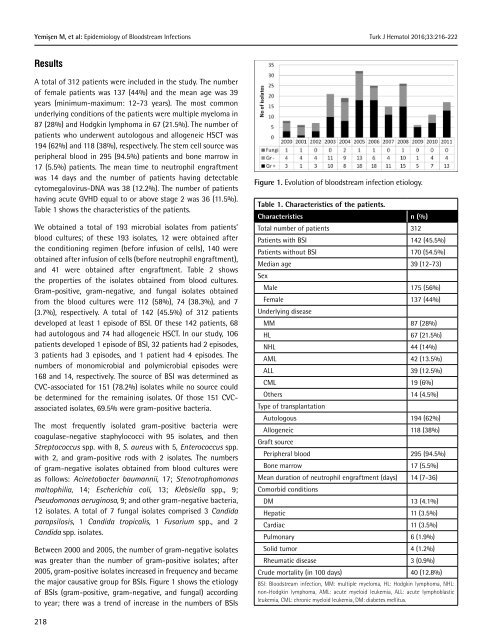Turkish Journal of Hematology Volume: 33 - Issue: 3
You also want an ePaper? Increase the reach of your titles
YUMPU automatically turns print PDFs into web optimized ePapers that Google loves.
Yemişen M, et al: Epidemiology <strong>of</strong> Bloodstream Infections<br />
Turk J Hematol 2016;<strong>33</strong>:216-222<br />
Results<br />
A total <strong>of</strong> 312 patients were included in the study. The number<br />
<strong>of</strong> female patients was 137 (44%) and the mean age was 39<br />
years (minimum-maximum: 12-73 years). The most common<br />
underlying conditions <strong>of</strong> the patients were multiple myeloma in<br />
87 (28%) and Hodgkin lymphoma in 67 (21.5%). The number <strong>of</strong><br />
patients who underwent autologous and allogeneic HSCT was<br />
194 (62%) and 118 (38%), respectively. The stem cell source was<br />
peripheral blood in 295 (94.5%) patients and bone marrow in<br />
17 (5.5%) patients. The mean time to neutrophil engraftment<br />
was 14 days and the number <strong>of</strong> patients having detectable<br />
cytomegalovirus-DNA was 38 (12.2%). The number <strong>of</strong> patients<br />
having acute GVHD equal to or above stage 2 was 36 (11.5%).<br />
Table 1 shows the characteristics <strong>of</strong> the patients.<br />
We obtained a total <strong>of</strong> 193 microbial isolates from patients’<br />
blood cultures; <strong>of</strong> these 193 isolates, 12 were obtained after<br />
the conditioning regimen (before infusion <strong>of</strong> cells), 140 were<br />
obtained after infusion <strong>of</strong> cells (before neutrophil engraftment),<br />
and 41 were obtained after engraftment. Table 2 shows<br />
the properties <strong>of</strong> the isolates obtained from blood cultures.<br />
Gram-positive, gram-negative, and fungal isolates obtained<br />
from the blood cultures were 112 (58%), 74 (38.3%), and 7<br />
(3.7%), respectively. A total <strong>of</strong> 142 (45.5%) <strong>of</strong> 312 patients<br />
developed at least 1 episode <strong>of</strong> BSI. Of these 142 patients, 68<br />
had autologous and 74 had allogeneic HSCT. In our study, 106<br />
patients developed 1 episode <strong>of</strong> BSI, 32 patients had 2 episodes,<br />
3 patients had 3 episodes, and 1 patient had 4 episodes. The<br />
numbers <strong>of</strong> monomicrobial and polymicrobial episodes were<br />
168 and 14, respectively. The source <strong>of</strong> BSI was determined as<br />
CVC-associated for 151 (78.2%) isolates while no source could<br />
be determined for the remaining isolates. Of those 151 CVCassociated<br />
isolates, 69.5% were gram-positive bacteria.<br />
The most frequently isolated gram-positive bacteria were<br />
coagulase-negative staphylococci with 95 isolates, and then<br />
Streptococcus spp. with 8, S. aureus with 5, Enterococcus spp.<br />
with 2, and gram-positive rods with 2 isolates. The numbers<br />
<strong>of</strong> gram-negative isolates obtained from blood cultures were<br />
as follows: Acinetobacter baumannii, 17; Stenotrophomonas<br />
maltophilia, 14; Escherichia coli, 13; Klebsiella spp., 9;<br />
Pseudomonas aeruginosa, 9; and other gram-negative bacteria,<br />
12 isolates. A total <strong>of</strong> 7 fungal isolates comprised 3 Candida<br />
parapsilosis, 1 Candida tropicalis, 1 Fusarium spp., and 2<br />
Candida spp. isolates.<br />
Between 2000 and 2005, the number <strong>of</strong> gram-negative isolates<br />
was greater than the number <strong>of</strong> gram-positive isolates; after<br />
2005, gram-positive isolates increased in frequency and became<br />
the major causative group for BSIs. Figure 1 shows the etiology<br />
<strong>of</strong> BSIs (gram-positive, gram-negative, and fungal) according<br />
to year; there was a trend <strong>of</strong> increase in the numbers <strong>of</strong> BSIs<br />
Figure 1. Evolution <strong>of</strong> bloodstream infection etiology.<br />
Table 1. Characteristics <strong>of</strong> the patients.<br />
Characteristics n (%)<br />
Total number <strong>of</strong> patients 312<br />
Patients with BSI 142 (45.5%)<br />
Patients without BSI 170 (54.5%)<br />
Median age 39 (12-73)<br />
Sex<br />
Male 175 (56%)<br />
Female 137 (44%)<br />
Underlying disease<br />
MM 87 (28%)<br />
HL 67 (21.5%)<br />
NHL 44 (14%)<br />
AML 42 (13.5%)<br />
ALL 39 (12.5%)<br />
CML 19 (6%)<br />
Others 14 (4.5%)<br />
Type <strong>of</strong> transplantation<br />
Autologous 194 (62%)<br />
Allogeneic 118 (38%)<br />
Graft source<br />
Peripheral blood 295 (94.5%)<br />
Bone marrow 17 (5.5%)<br />
Mean duration <strong>of</strong> neutrophil engraftment (days) 14 (7-36)<br />
Comorbid conditions<br />
DM 13 (4.1%)<br />
Hepatic 11 (3.5%)<br />
Cardiac 11 (3.5%)<br />
Pulmonary 6 (1.9%)<br />
Solid tumor 4 (1.2%)<br />
Rheumatic disease 3 (0.9%)<br />
Crude mortality (in 100 days) 40 (12.8%)<br />
BSI: Bloodstream infection, MM: multiple myeloma, HL: Hodgkin lymphoma, NHL:<br />
non-Hodgkin lymphoma, AML: acute myeloid leukemia, ALL: acute lymphoblastic<br />
leukemia, CML: chronic myeloid leukemia, DM: diabetes mellitus.<br />
218

















